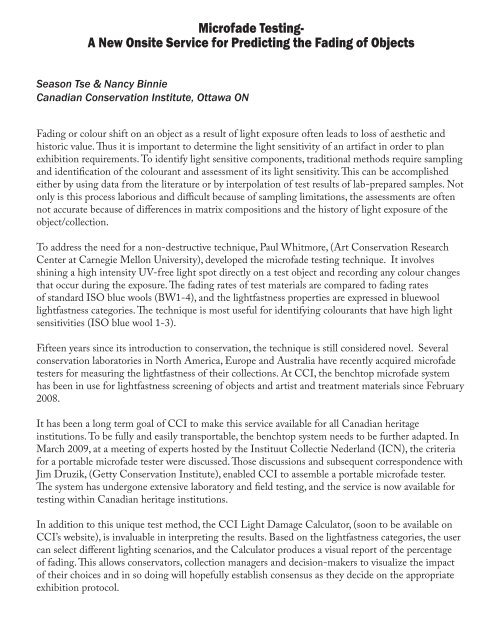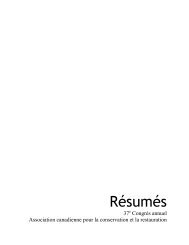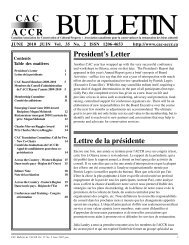Ottawa - Canadian Association for Conservation
Ottawa - Canadian Association for Conservation
Ottawa - Canadian Association for Conservation
Create successful ePaper yourself
Turn your PDF publications into a flip-book with our unique Google optimized e-Paper software.
Microfade Testing-<br />
A New Onsite Service <strong>for</strong> Predicting the Fading of Objects<br />
Season Tse & Nancy Binnie<br />
<strong>Canadian</strong> <strong>Conservation</strong> Institute, <strong>Ottawa</strong> ON<br />
Fading or colour shift on an object as a result of light exposure often leads to loss of aesthetic and<br />
historic value. Thus it is important to determine the light sensitivity of an artifact in order to plan<br />
exhibition requirements. To identify light sensitive components, traditional methods require sampling<br />
and identification of the colourant and assessment of its light sensitivity. This can be accomplished<br />
either by using data from the literature or by interpolation of test results of lab-prepared samples. Not<br />
only is this process laborious and difficult because of sampling limitations, the assessments are often<br />
not accurate because of differences in matrix compositions and the history of light exposure of the<br />
object/collection.<br />
To address the need <strong>for</strong> a non-destructive technique, Paul Whitmore, (Art <strong>Conservation</strong> Research<br />
Center at Carnegie Mellon University), developed the microfade testing technique. It involves<br />
shining a high intensity UV-free light spot directly on a test object and recording any colour changes<br />
that occur during the exposure. The fading rates of test materials are compared to fading rates<br />
of standard ISO blue wools (BW1-4), and the lightfastness properties are expressed in bluewool<br />
lightfastness categories. The technique is most useful <strong>for</strong> identifying colourants that have high light<br />
sensitivities (ISO blue wool 1-3).<br />
Fifteen years since its introduction to conservation, the technique is still considered novel. Several<br />
conservation laboratories in North America, Europe and Australia have recently acquired microfade<br />
testers <strong>for</strong> measuring the lightfastness of their collections. At CCI, the benchtop microfade system<br />
has been in use <strong>for</strong> lightfastness screening of objects and artist and treatment materials since February<br />
2008.<br />
It has been a long term goal of CCI to make this service available <strong>for</strong> all <strong>Canadian</strong> heritage<br />
institutions. To be fully and easily transportable, the benchtop system needs to be further adapted. In<br />
March 2009, at a meeting of experts hosted by the Instituut Collectie Nederland (ICN), the criteria<br />
<strong>for</strong> a portable microfade tester were discussed. Those discussions and subsequent correspondence with<br />
Jim Druzik, (Getty <strong>Conservation</strong> Institute), enabled CCI to assemble a portable microfade tester.<br />
The system has undergone extensive laboratory and field testing, and the service is now available <strong>for</strong><br />
testing within <strong>Canadian</strong> heritage institutions.<br />
In addition to this unique test method, the CCI Light Damage Calculator, (soon to be available on<br />
CCI’s website), is invaluable in interpreting the results. Based on the lightfastness categories, the user<br />
can select different lighting scenarios, and the Calculator produces a visual report of the percentage<br />
of fading. This allows conservators, collection managers and decision-makers to visualize the impact<br />
of their choices and in so doing will hopefully establish consensus as they decide on the appropriate<br />
exhibition protocol.





